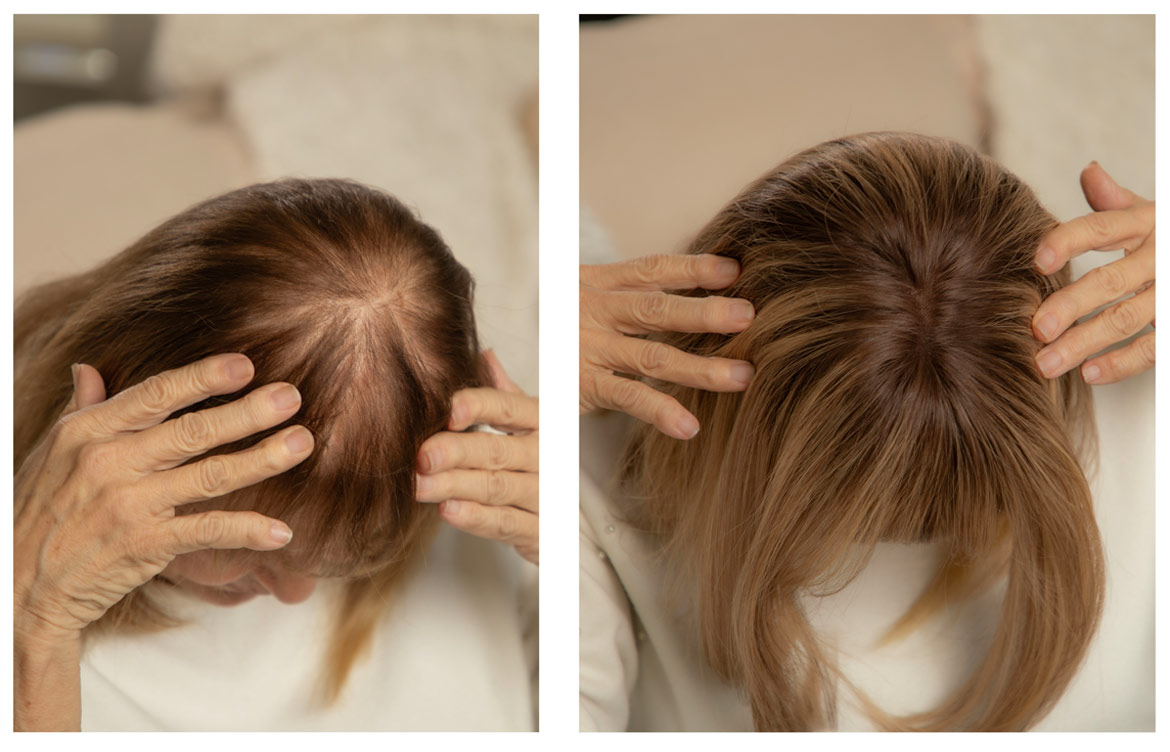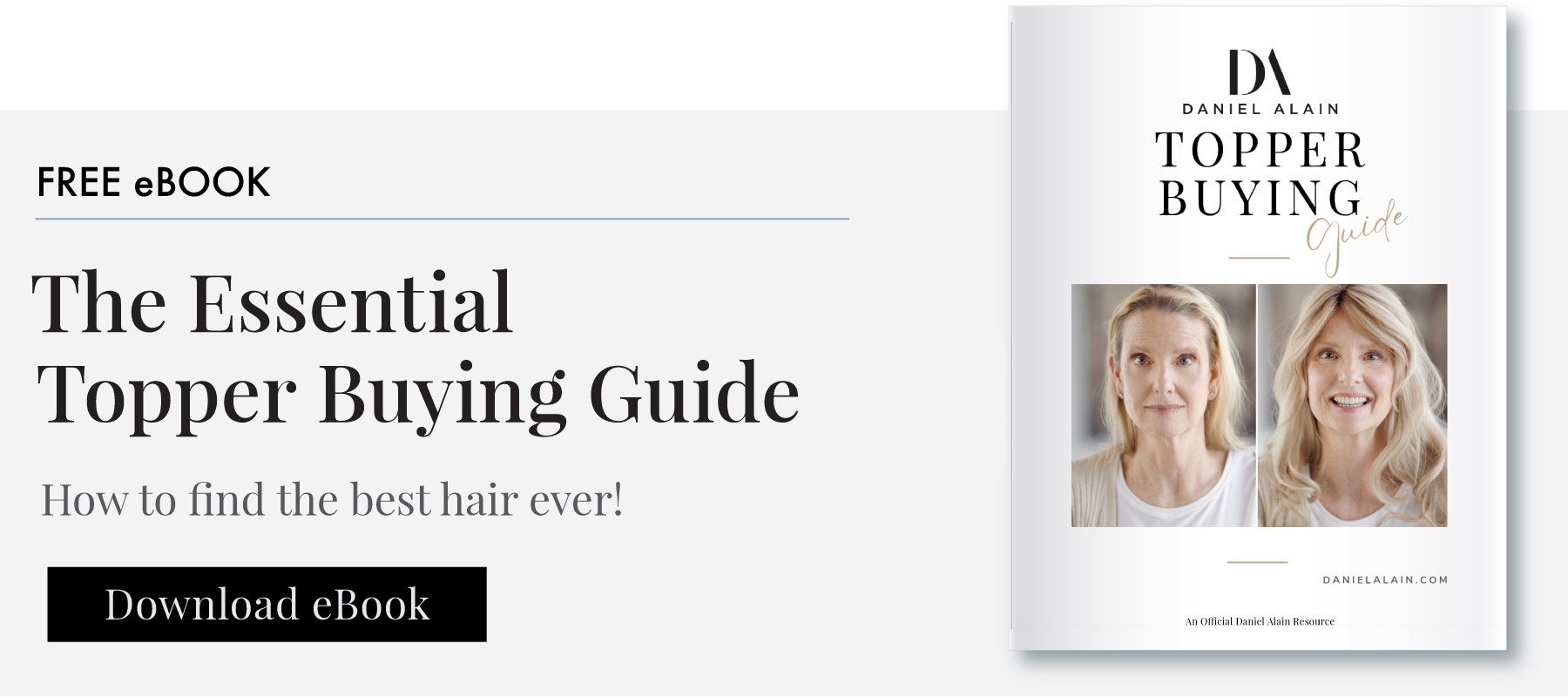A Guaranteed Solution for Dealing With a Widening Part

Have you caught a glimpse of your part in the mirror and noticed that it seems to be wider than it used to be?
If so, this change may leave you feeling a bit anxious or self-conscious, wondering if it’s just your imagination or a sign of something more?
It’s completely natural to feel a mix of emotions about changes in your appearance. This article is here to guide you through understanding what a widening part means, why it happens, and most importantly, what you can do about it.
Whether you're exploring the guaranteed solution of hair toppers or seeking advice on selecting the perfect one, we’ll guide you through it all. This article focuses on the advantages of hair toppers as an immediate answer to hair thinning and provides essential tips for choosing the right topper to meet your needs.
Why is my part widening?
A widening part is essentially what it sounds like: the area of the scalp visible along the line where your hair divides becomes broader over time. This phenomenon is more than just a day-to-day fluctuation in hair volume or the result of trying out a new hairstyle.
Instead, it's a gradual process that may indicate an increase in hair thinning or loss, making more of the scalp visible than before. Unlike normal variations in hair parting, which can change based on how you style your hair, a widening part is persistent and may become more noticeable over time, reflecting changes in hair density and scalp coverage.
The reasons behind a widening part can be as varied as they are complex, often involving a combination of genetic, hormonal, and environmental factors. Understanding these can provide insight into potential strategies for management and prevention:
- Genetic Factors: Just as the color, texture, and type of your hair are inherited traits, so too can be your predisposition to hair thinning or loss. If you have family members who have experienced similar changes, genetics may play a role in your widening part.
- Hormonal Changes: Hormones are powerful regulators of many bodily processes, including hair growth and loss. Women, in particular, may notice changes in hair density during periods of hormonal fluctuation, such as pregnancy, menopause, or as a result of using hormonal birth control. Conditions like polycystic ovary syndrome (PCOS) can also influence your hair's health.
- Stress: Both physical and emotional stress can impact your hair. Telogen effluvium, for example, is a condition where significant stress pushes large numbers of hair follicles into a resting phase, followed by hair shedding and thinning. Once the stressor is removed, hair usually begins to regrow, but the interim period can contribute to a widening part.
- Hairstyles and Treatments: Certain ways of styling your hair, especially those that pull tightly on the roots (like tight ponytails, braids, or hair extensions), can cause tension on the scalp and potentially lead to a form of hair loss known as traction alopecia. Similarly, frequent use of heat styling tools, chemical relaxers, or dyes can weaken hair strands and contribute to thinning.
The problem with hair regrowth treatments
Hair regrowth treatments require hope, patience, and realistic expectations, because the effectiveness of these interventions can vary significantly from person to person.
Supplements and iron are often touted for their potential to nourish hair follicles and mitigate thinning, particularly when hair loss is linked to dietary deficiencies. However, it’s important to understand that not everyone will see dramatic regrowth from supplements alone, and any improvement can be slow to manifest.
Similarly, topical treatments such as minoxidil offer a non-invasive approach to stimulating hair growth and improving density, yet they demand consistent application and patience, with results taking several months to become noticeable.
For people considering more direct measures, options like hair transplant surgery and platelet-rich plasma (PRP) therapy present more invasive but potentially effective solutions, though they come with higher costs, greater risks, and variable outcomes.
Across all these treatments, it’s important to manage expectations and recognize that hair growth is a gradual process and that interventions may not work universally.
Consulting with a healthcare professional and carefully weighing the options can help guide you toward the most suitable approach for your specific situation.
Hair Toppers for instant results
So, what are you to do if you’re not seeing satisfactory results from hair regrowth treatments, or if you’re seeking an immediate solution to a widening part?
Enter hair toppers - an easy solution that offers instant, guaranteed results that can significantly enhance your appearance and confidence. These hairpieces are designed to conceal areas of thinning at the top of the head and seamlessly integrate with your existing hair for a natural look.
Whether used in conjunction with ongoing hair regrowth treatments or as a standalone solution, hair toppers are an effective way to address hair thinning concerns without the wait or unpredictability associated with other treatments.
Choosing the Right Hair Topper
Selecting the perfect hair topper involves several considerations to ensure a natural, comfortable fit:
- Color Match: Finding a topper that closely matches your hair color is important for a seamless blend. Many brands offer a wide range of shades or custom coloring services to achieve the perfect match.
- Texture and Style: Choosing a topper with a similar texture to your natural hair will ensure they blend together seamlessly. Consider how you typically style your hair as well; some toppers allow for heat styling, such as human hair toppers, while others do not.
- Coverage: Toppers come in various base sizes to address different thinning patterns. Assess the area of your scalp you wish to cover to determine the appropriate base size for your topper.
Benefits of Hair Toppers
One of our customers, Sara, has been wearing a human hair topper for a few years after thinning hair led her to seek an instant solution to a widening part line and increasingly visible scalp. She has enthusiastically embraced her hair topper and a newfound confidence in her appearance.

“Wearing a hair topper is like finding the missing piece of my puzzle,” she shares. “I wear glasses to see better, I wear makeup to look younger, and I wear a hair topper to give my natural hair something extra!”
The advantages of incorporating a hair topper into your styling routine are:
- Instant Volume and Coverage: Hair toppers immediately add fullness to thinning areas, effectively concealing a widening part and restoring a more youthful, voluminous look to your hair.
- Confidence Boost: Many individuals experience a significant boost in self-esteem and confidence with the added volume and coverage a topper provides. Knowing your hair looks full and natural can alleviate the stress and self-consciousness associated with hair thinning.
- Versatility and Ease of Use: Hair toppers offer the flexibility to change your look without permanent alterations. They can be easily applied and removed, making them a convenient option for everyday wear or special occasions.
What are my next steps in addressing my widening part?
A widening part may be a distressing visible reminder of the hair thinning you’re experiencing.
If we’ve given you some food for thought and piqued your interest in hair toppers as an instant, guaranteed solution, we invite you to reach out to our team of consultants who can answer any questions you may have. A personalized consultation with an expert can help empower you to make the right decision for you.

.jpeg)
